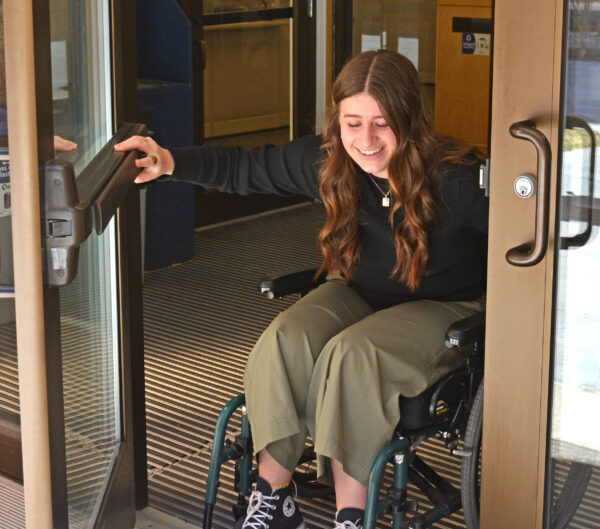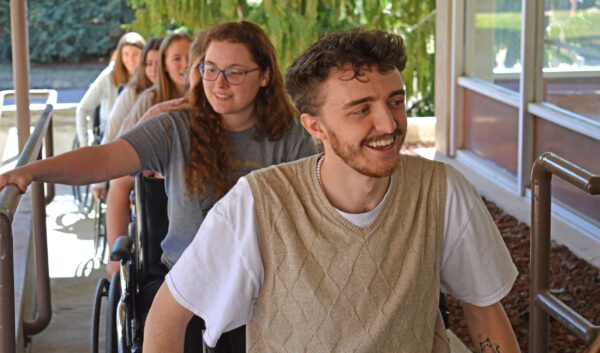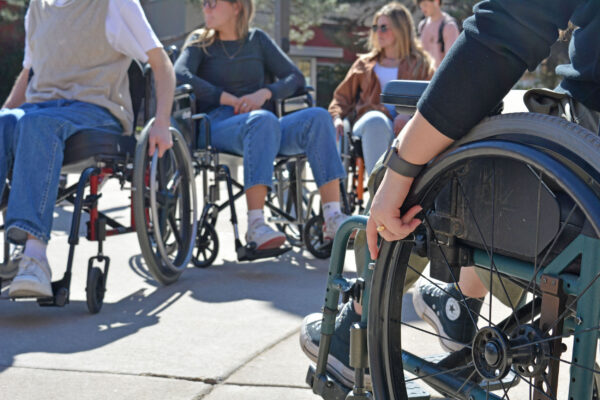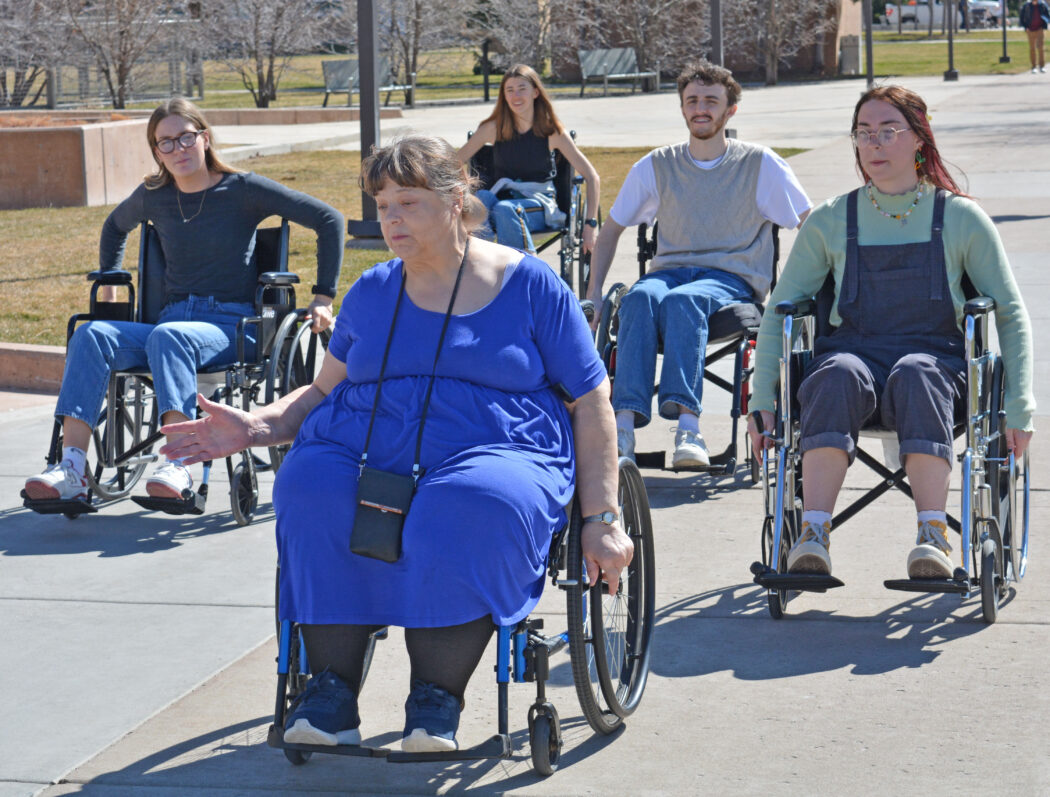Students learn about wheelchair accessibility on campus
Nine Utah State University students experienced an hour in a wheelchair as part of their SPeD 5500 Interdisciplinary Disability Awareness and Community-Engaged Learning class.
The students began at the Institute for Disability Research, Policy and Practice (IDRPP) building, where they borrowed wheelchairs and traversed around campus, traveling to the Junction, across several crosswalks and through the cemetery. Potholes, uneven ground and sidewalk curbs with no curb cuts proved difficult to maneuver, as well as the steep ramp up to the Junction.
“We just didn’t realize there were so many obstacles present in our community,” said Anja Cieslewicz, a student who participated in the experience.
Another major hurdle? Heavy double doors to enter buildings.
“There’s quite a few doors on campus that don’t have the automatic push buttons, and it was kind of a struggle,” Cieslewicz said.

Ellie Miller practices opening a door while in a wheelchair on March 20.
Although there were kind-hearted people not involved in the experience who wanted to help the students through the doors, the students had to refuse their assistance and open the doors themselves. To enter the door, they had to place one hand on the door handle and push the door open as the other hand was pushing a wheel to move the wheelchair into the building.
Mary Ellen Heiner, professor of the class, gave a student a pressure gauge to test the amount of force needed to open the front door of the IDRPP building. It took nine pounds of pressure.
Most doors on campus do not meet the American Disabilities Act (ADA) standard of five pounds of force to open the door, said Heiner. The doors are heavy, and without help it’s awkward and difficult to enter a building.
Some of the wheelchairs were more suited than others for the often treacherous journey through campus, with bigger wheels or more traction on the wheels.
“Uh oh, you’re off-roading,” one of the participants said as a wheelchair veered off the sidewalk into the grass.
Most sidewalks aren’t completely flat, as there is a cross slope allowing for drainage into the curb. However, if the slope is above two percent, it can make it difficult for wheelchairs to travel down the sidewalk.
“I obviously knew being in a wheelchair was hard, but I didn’t realize it was that hard,” said Maren Thomson, a student who also participated. “I didn’t realize how steep the ramps were. Or, you think that a sidewalk is flat, but it’s actually really steep.”

Members of the SpEd 5500 class practice going up a ramp in a wheelchair on March 20.
Thomson recently got surgery on her ankle and has been experiencing campus in a different way.
“I’ve been on crutches for a couple weeks and then I had a little knee scooter for a couple of weeks,” she said. Thomson has had ankle problems since high school and a surgery last year didn’t fix them, so she had surgery again. Thomson said in some ways it was easier to travel with a wheelchair, because she had more accessibility with her hands, but in other ways it was more difficult.
“You have zero mobility with your feet. So a wheelchair is different because you can’t cut corners as easy or go in tighter spaces,” Thomson said.
In Thompson’s words, the experience was ‘insightful’.
“None of the buildings on campus are actually fully ADA accessible,” Cieslewicz said. “So even just making those bare minimum requirements could go a long way to making sure that the ramps aren’t too steep and the doors aren’t too heavy to push open.”
Heiner said architects often want something to look aesthetically pleasing, sacrificing functionality. Courtyards and sidewalks with large cracks may look pretty, but make it easy for wheelchair wheels to get caught.
One hour isn’t enough to experience what life is like in a wheelchair, said Heiner. Because of a farming accident as a child, Heiner herself has been on crutches or in a wheelchair for several decades.
“The purpose for this wheelchair exercise is to make you aware of the barriers that people in wheelchairs face so that you can do something about them,” she said. Opening a door, a sloped pathway or cracks in the sidewalk are just a few simple examples of barriers people may not think about if they’re not in a wheelchair.

“I’ve told my students I don’t ever, ever, ever want them to refer to somebody as normal,” Heiner said. Instead of treating everyone like ‘normal’ people, Heiner said to treat everyone as people.
Heiner spoke about a time when she had to enter a restaurant through the back door and go through the kitchen, as it was the only wheelchair accessible entrance. Another time she went to a hotel claiming to have a wheelchair friendly room, but it was on the second floor with no elevator. Heiner ended up sleeping on a mattress on the ground, as the bed was too high for her to get into.
“We hear a lot about inclusive,” Heiner said. “It’s so much more than just inclusion. It’s belonging. You can include somebody but you don’t have to make them feel like they belong.”

